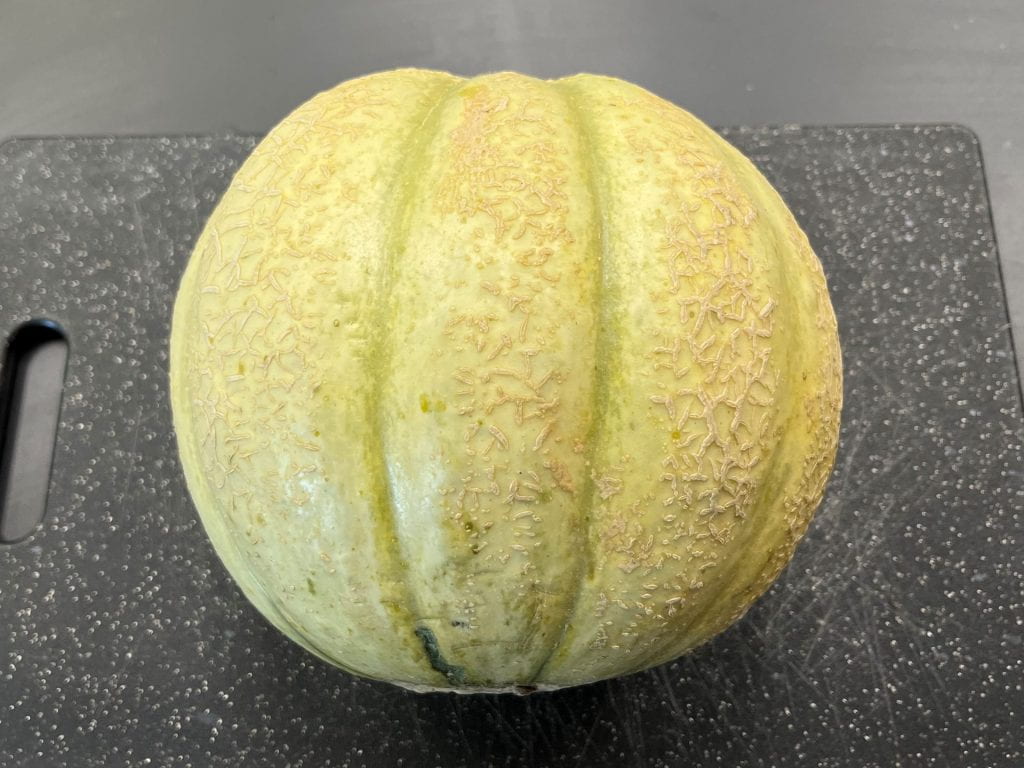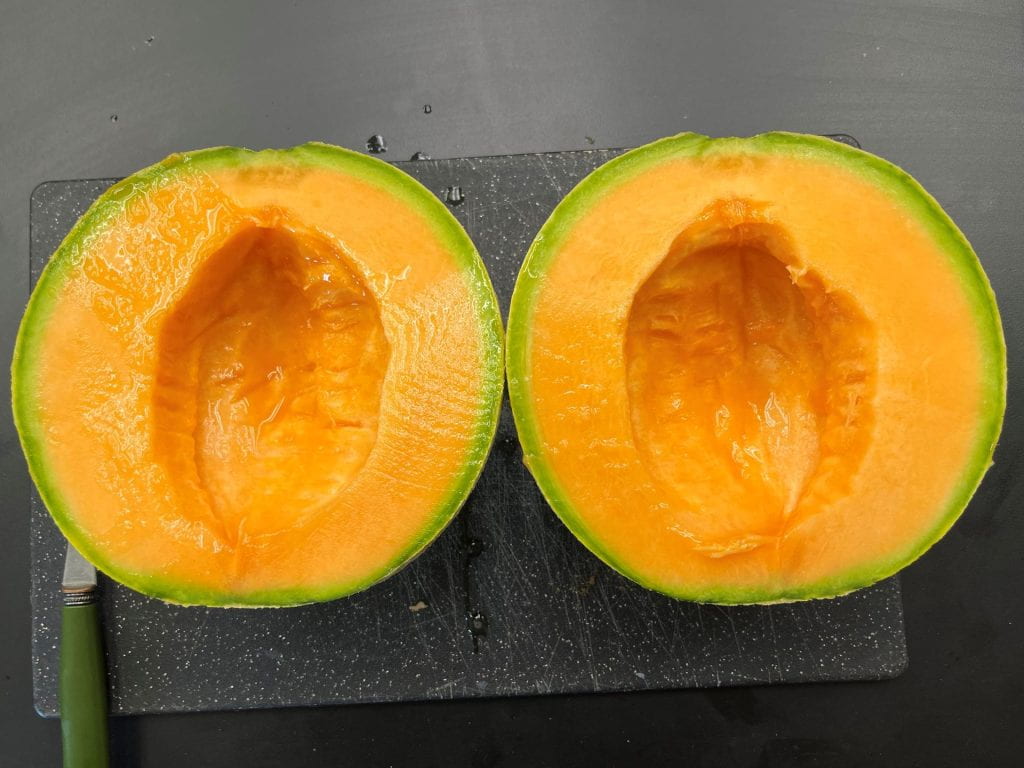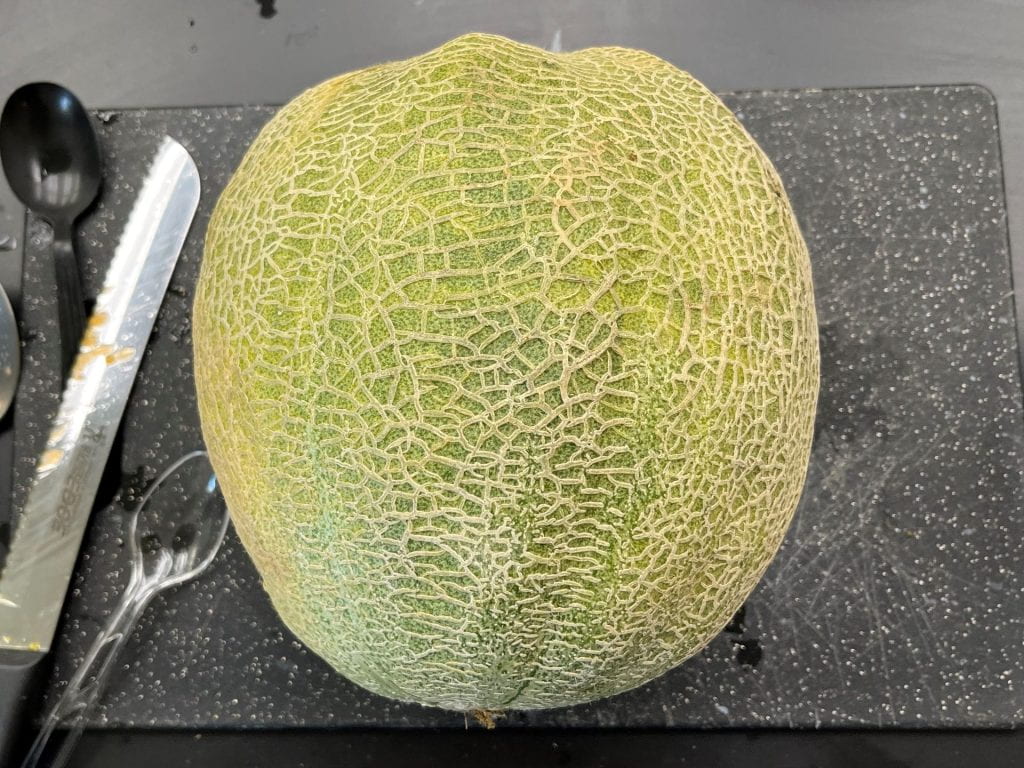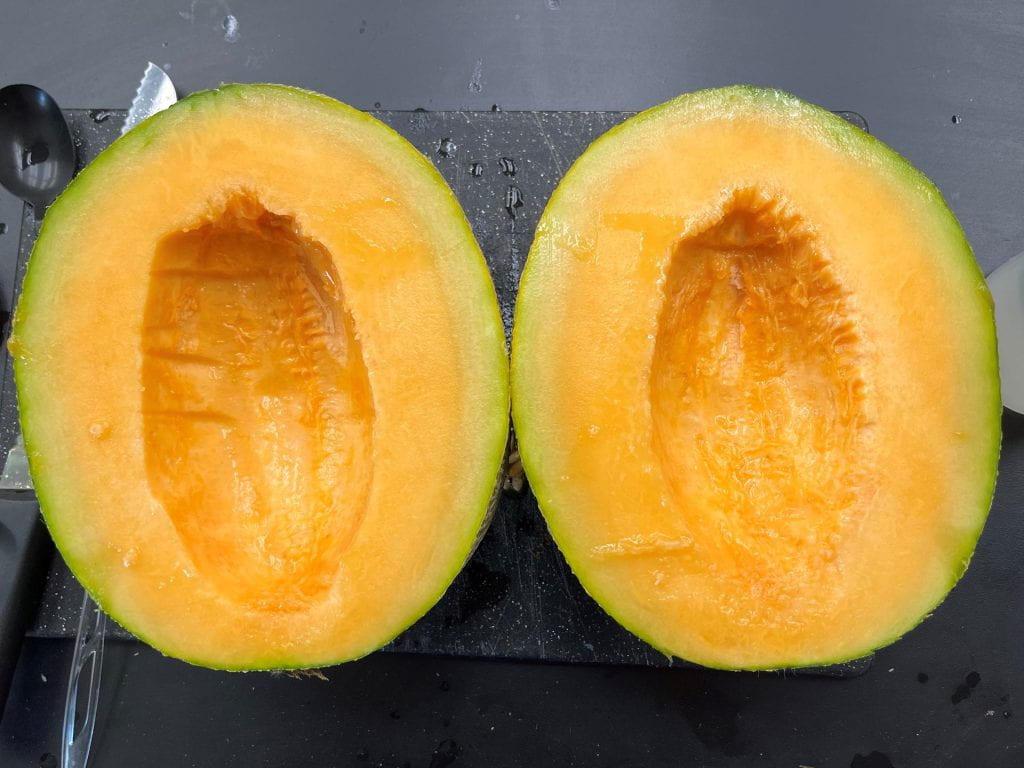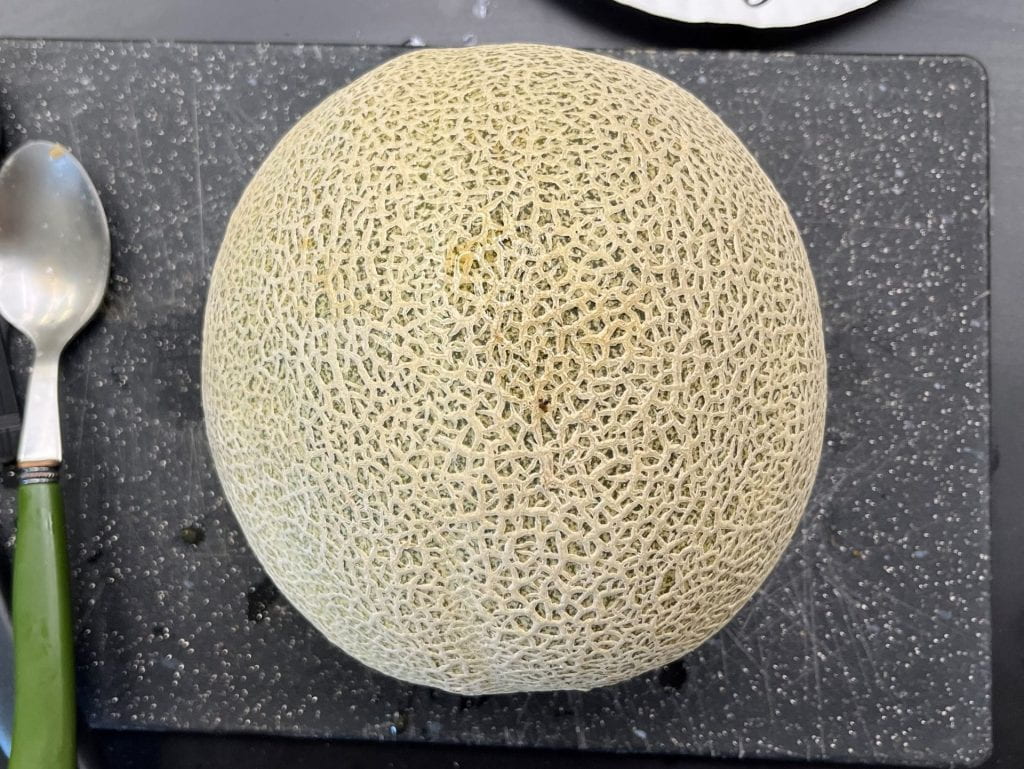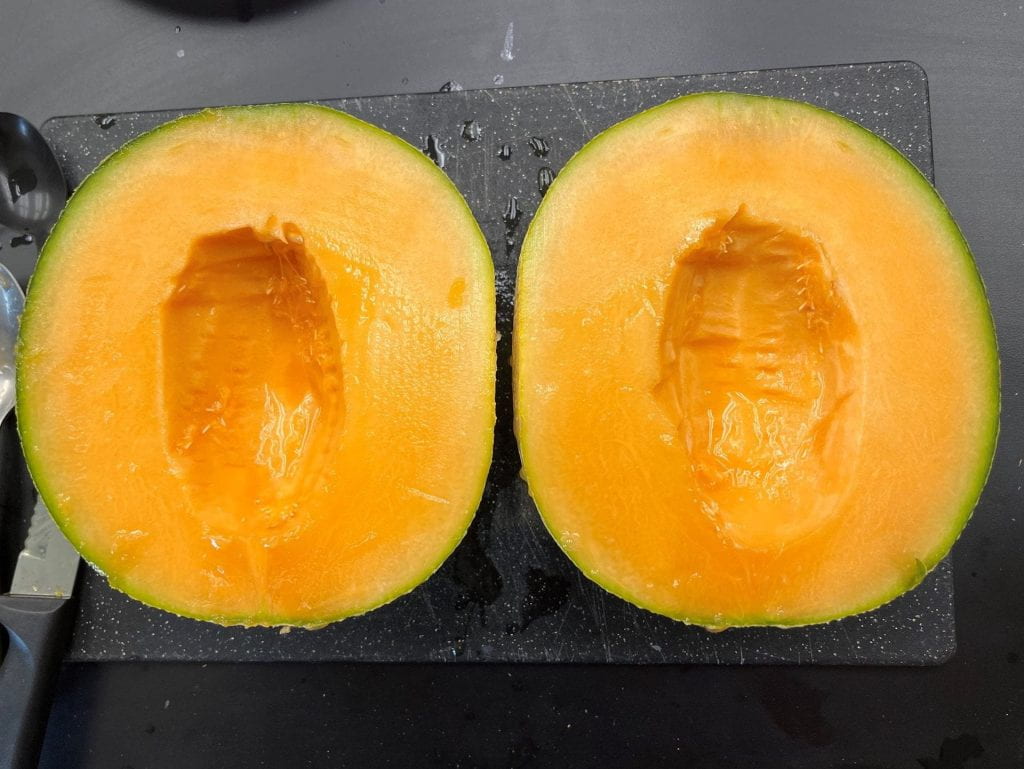This replicated experiment was conducted at LIHREC in 2022.
Topics on this page:
Margaret Tuttle McGrath
Plant Pathology and Plant-Microbe Biology Section, SIPS, Cornell University
Long Island Horticultural Research and Extension Center
3059 Sound Avenue, Riverhead, NY 11901; mtm3@cornell.edu
Downy mildew is a common disease affecting foliage of cantaloupe crops most years on Long Island. When it is not effectively managed, leaves die prematurely, and as a result, fruit has poor flavor and lacks sweetness. While common, this disease occurs sporadically. First observation of downy mildew in cantaloupe on Long Island has varied from 4 August to 20 September; twice in the past 14 years symptoms on cantaloupe were not observed in the LIHREC sentinel plots or commercial crops on Long Island. The pathogen survives over winter in southern Florida and then moves northward with the growing season moving among crops via its wind-dispersed spores. The specific downy mildew pathogen (clade) that infects cantaloupe also infects cucumber.
Applying fungicides on a weekly, preventive schedule is recommended for managing downy mildew. Applying fungicides when risk is predicted at the cucurbit downy mildew forecast website for where a crop is being grown helps target application timing and avoid some unnecessary applications, but there can be several high-risk forecasts before infection occurs. By using an integrated management program, consisting of fungicides applied to a resistant variety, the suppression provided by the plant’s genetic resistance could enable achieving effective control with fungicide applications started after finding symptoms in the crop. Downy mildew resistant cantaloupe varieties evaluated at LIHREC in 2021 exhibited good control of downy mildew, but not as good as some resistant cucumber varieties or good enough to ensure no impact of diseased foliage on fruit quality, and control was improved by applying fungicides for downy mildew to these varieties, indicating that an integrated management program (fungicides applied to a resistant variety) is the best approach for managing this important disease in cantaloupe. Additionally, an integrated approach will reduce selection pressure on the pathogen for fungicide resistance, which the pathogen has proven adept at achieving.
Trifecta (which was developed at Cornell), Planter’s Jumbo, and Edisto 47 are cantaloupe varieties with resistance to both downy mildew and powdery mildew. Two were evaluated in 2021. There are several other varieties resistant to just powdery mildew. Growing a variety with resistance to both of these common diseases would enable achieving effective control with less fungicide use.
The goal of this experiment conducted at LIHREC in 2022 was to determine if downy mildew can be effectively managed with a weekly program of targeted fungicides applied on an IPM schedule (started after observing symptoms) to resistant varieties. Treatments included to achieve this objective were susceptible and resistant varieties left untreated and treated with a similar fungicide program on the recommended preventive schedule. The IPM fungicide schedule was also implemented on the susceptible variety. Yield and fruit quality were also examined. It is helpful for growers to know how well new varieties perform in terms of ability to suppress a disease, in order to select a fungicide program to achieve desired level of control, and also to know yield and fruit quality compared to standard varieties to determine whether a new variety is suitable for their operation. While not an objective of this experiment, effective management might be possible with further reduction in applications to a resistant variety by extending the application interval or shortening the treatment period.
Procedures
Mustard was grown in spring for biofumigation to manage the Phytophthora blight pathogen in the soil before planting the experiment. The field was moldboard plowed on 23 March and urea fertilizer (46-0-0) was applied at 80 lb/A N immediately after, followed by seeding a mustard cover crop (Rojo Caliente) at 10 lb/A by drilling. On 8 June the mustard was flail-chopped, immediately incorporated by disking, and followed by a cultipacker to seal the soil surface; the field could not be irrigated to initiate biofumigation as usually done, but the soil was considered moist enough to obtain activity. The following fungicides were applied to manage Phytophthora blight: Revus 8 fl oz/A applied on 14 and 26 July, and Presidio 4 fl oz/A applied on 19 July and 2 August. They were selected because they were ineffective against downy mildew in recent seedling bioassays assumed due to fungicide resistance in the pathogen.
Controlled-release fertilizer (N-P-K, 19-10-9) at 525 lb/A (101 lb/A N) was broadcast over the bed area and incorporated on 5 July. Beds were formed with drip tape and covered with black plastic mulch on 12 July. Seeds were sown in the greenhouse on 27 June. A waterwheel transplanter was used to make planting holes in the beds and apply starter fertilizer (9-18-9). Seedlings were placed outdoors to harden for a few days before transplanting by hand into the holes in the beds on 18 and 19 July. During the season, water was provided as needed via drip irrigation lines. Weeds were managed between the mulched beds by applying herbicide before transplanting and by hand weeding.
Fungicides were applied to the experiment to manage powdery mildew because Ambrosia, the downy mildew susceptible variety used for comparison to the resistant varieties, is also susceptible to powdery mildew and development of this disease would have confounded downy mildew development. Fungicides applied were Procure 6 fl oz/A on 4 August, Procure 8 fl oz/A on 15 August and 6 September, Vivando 15 fl oz/A on 10 and 29 August and 12 September, and Quintec 6 fl oz/A on 22 August.
Plots were three 10-ft rows spaced 68 in. apart with 10 to 12 plants per plot at 2-ft spacing. The plots were 14 ft apart within the row initially until plants began to vine, partly filling the area. Vines were moved as needed to maintain plot separation. A randomized complete block design with four replications was used.
The fungicide program used for downy mildew was Ranman 2.75 fl oz/A applied on 27 July, 17 August, and 8 September, Previcur Flex 1.2 pt/A on 3 and 25 August, and Orondis Ultra 7 fl oz/A on 9 and 30 August. Applications were started on 27 July for the preventive treatments (seven total) and starting on 17 August for the IPM treatments (four total). They were made using a tractor-mounted boom sprayer equipped with twinjet (TJ60-11004VS) nozzles spaced 17 in. apart that delivered 72 gal/A at 55 psi and 2.3 mph. There were high risk forecasts for successful spread of the pathogen to Long Island on 25 and 28 July.
Downy mildew severity was assessed weekly from 17 August through 15 September by estimating incidence of symptomatic leaves in each plot and rating severity on nine representative affected leaves. Canopy severity was calculated by multiplying incidence by average severity. Area under disease progress curve (AUDPC) values were calculated from 17 August through 15 September. AUDPC is a summation measure of severity over time. Defoliation was assessed by estimating the percent of foliage lost due to downy mildew on 15 and 20 September.
Ripe fruit were harvested and rotten fruit were counted on 16, 21, and 27 September. A refractometer was used to measure sugar content (Brix) of one fruit per plot for some treatments on each harvest date. Appearance, taste, texture, and marketability were rated without knowledge of treatment for fruit harvested on each date from fungicide-treated plots and from untreated plots of Ambrosia by LIHREC staff and gardeners on a 1 (poor) to 5 (excellent) scale as interpreted by the rater. Total of 20 ratings were obtained. All remaining fruit were counted on 3 October.
Results
Symptoms of downy mildew were first observed on 8 August (20 days after transplanting and 12 days after the first preventive application) on one leaf in each of 5 plots. The untreated susceptible variety Ambrosia was numerically and usually significantly more severely affected by downy mildew than the untreated resistant variety Trifecta (Table 1). Compared to untreated Ambrosia, untreated Trifecta provided 29% control based on AUDPC values and 72% control based on defoliation. Control of downy mildew was substantially improved with either fungicide program applied to Trifecta (100%). The IPM fungicide application schedule was as effective as the preventive schedule for managing downy mildew on Ambrosia (98% control) although it was hypothesized that this might only be the case with a resistant variety. There usually were more symptoms of downy mildew on Ambrosia treated with fungicides on the IPM schedule than on the three resistant varieties receiving the same fungicide program, but differences were not significant. There were no significant differences in downy mildew control among the three resistant varieties treated with targeted fungicides on the IPM schedule.
Applying fungicides to control downy mildew on Ambrosia resulted in significantly larger fruit (average weight of 3.9 lb versus 4.9 lb) with significantly higher sugar content based on Brix values, which is associated with better flavor. Trifecta had significantly higher sugar content than the other varieties except Edisto 47. Edisto 47 produced the largest fruit (5.7 lb) and thus, not surprisingly, the fewest fruit. Trifecta received highest average ratings for taste, texture, and internal appearance, and all assessments had yes response for ‘would you buy?’ (Table 2). Planter’s Jumbo received highest average ratings for shape and external appearance. Fruit of Ambrosia from fungicide-treated plots were rated higher than fruit from untreated plots for all variables except size, most notably for taste (3.6 versus 2.4).
Conclusions
Similarly excellent control was achieved with a conventional fungicide program applied starting after symptoms found (IPM schedule) to the resistant varieties Trifecta, Edisto 47, and Planter’s Jumbo as well as susceptible Ambrosia. Genetic downy mildew resistance provided moderate suppression (29%) based on comparison of untreated Trifecta and untreated Ambrosia. Trifecta was the best variety in this experiment based on its fruit having highest sugar content (Brix) and highest average ratings for taste, texture, and internal appearance.
Additional information: At the Cornell Vegetables website there are lists and tables of resistant vegetable varieties that include seed companies marketing them and whether organic seed is available, as well as variety resistance to disorders, and also additional information about downy mildew and its management.
Margaret Tuttle McGrath
Plant Pathology and Plant-Microbe Biology Section, SIPS, Cornell University
Long Island Horticultural Research and Extension Center
3059 Sound Avenue, Riverhead, NY 11901
mtm3@cornell.edu
Acknowledgments: This project was supported by the National Institute of Food and Agriculture, U.S. Department of Agriculture, Hatch under NYC-153948 and the Friends of Long Island Horticulture Grant Program.
Tables
Table 1. Ability to suppress downy mildew, defoliation due to downy mildew, yield, and fruit quality of different cantaloupe varieties receiving different fungicide programs.
| Variety z (fungicide program) | Downy mildew canopy severity (%) y | Defoliation (%) y | Yield and fruit quality y | |||||||||||||
| 7 Sep x | 15 Sep | 20 Sep | AUDPC x | 20 Sep x | # Fruit/plant | Brix | ||||||||||
| Ambrosia (untreated) | 48.3 | a | 27.4 | a | ND | 452.2 | a | 98 | a | 4.3 | abc | 6.5 | c | |||
| Ambrosia (preventive) | 0.7 | b | 0.8 | c | 3.4 | bc | 9.0 | c | 4 | bc | 4.8 | a | 10.7 | b | ||
| Ambrosia (IPM) | 1.4 | b | 0.1 | c | 5.5 | b | 10.8 | c | 4 | bc | 4.8 | a | ND | |||
| Trifecta (untreated) | 37.5 | a | 14.0 | b | 28.5 | a | 320.5 | b | 27 | b | 3.7 | bc | ND | |||
| Trifecta (preventive) | 0.1 | b | 0.0 | c | 0.7 | c | 1.0 | c | 2 | c | 4.7 | ab | ND | |||
| Trifecta (IPM) | 0.2 | b | 0.0 | c | 1.4 | bc | 1.9 | c | 1 | c | 4.3 | ab | 12.1 | a | ||
| Edisto 47 (IPM) | 0.2 | b | 0.1 | c | 3.4 | bc | 2.4 | c | 4 | bc | 3.3 | c | 10.9 | ab | ||
| Planter’s Jumbo (IPM) | 0.9 | b | 0.0 | c | 2.4 | bc | 6.5 | c | 7 | bc | 4.5 | ab | 9.6 | b | ||
| P-value (treatment) | <0.0001 | <0.0001 | <0.0001 | <0.0001 | <0.0001 | 0.0004 | <0.0001 | |||||||||
z Ambrosia is susceptible to downy mildew. Edisto 47, Planter’s Jumbo, and Trifecta are marketed as being resistant to downy mildew.
y Numbers in each column with a letter in common or no letters are not significantly different from each other (Tukey’s HSD, P=0.05).
ND = not determined.
x Values were square root transformed before analysis because raw data were not distributed normally. Table contains de-transformed values.
Table 2. Average ratings for fruit of susceptible and resistant varieties of cantaloupe evaluated on a 1 (poor) to 5 (excellent) scale for several parameters by 20 people. Comments made by the raters follow.
| Variety (fungicide program) | Appearance | Would you buy? | ||||||
| Size | Shape | External | Internal | Taste | Texture | Average | ||
| Ambrosia (untreated) | 4.3 | 3.9 | 3.6 | 3.0 | 2.4 | 2.8 | 3.3 | 26% |
| Ambrosia (preventive) | 4.1 | 4.2 | 4.1 | 3.7 | 3.6 | 3.6 | 3.9 | 74% |
| Trifecta (IPM) | 4.3 | 4.4 | 3.9 | 4.8 | 4.7 | 4.4 | 4.4 | 100% |
| Edisto 47 (IPM) | 4.1 | 3.6 | 3.3 | 3.1 | 2.2 | 2.6 | 3.1 | 21% |
| Planter’s Jumbo (IPM) | 4.3 | 4.5 | 4.5 | 4.1 | 3.0 | 3.6 | 4.0 | 47% |
| Variety (fungicide program) | Comments |
| Ambrosia (untreated) | mealy texture, not sweet (2), too mild (2), too long, juicy, soft, chemical aftertaste |
| Ambrosia (preventive) | not fully ripe, good texture, good flavor (2), sweet (3), too soft, flavor not full |
| Trifecta (IPM) | deep orange flesh (2), sweet (2), firm (2), good flavor (3), favorite (2), thicker rind, harder fruit, no netting (2), nice aroma, would buy based on taste only, not very moist |
| Edisto 47 (IPM) | bleh, mealy (2), little overripe, bad flavor (3), too soft, sweet, fibrous, nice color |
| Planter’s Jumbo (IPM) | bad flavor (5), bad aftertaste (3), mild taste (2), not sweet (2), nice color |
Images
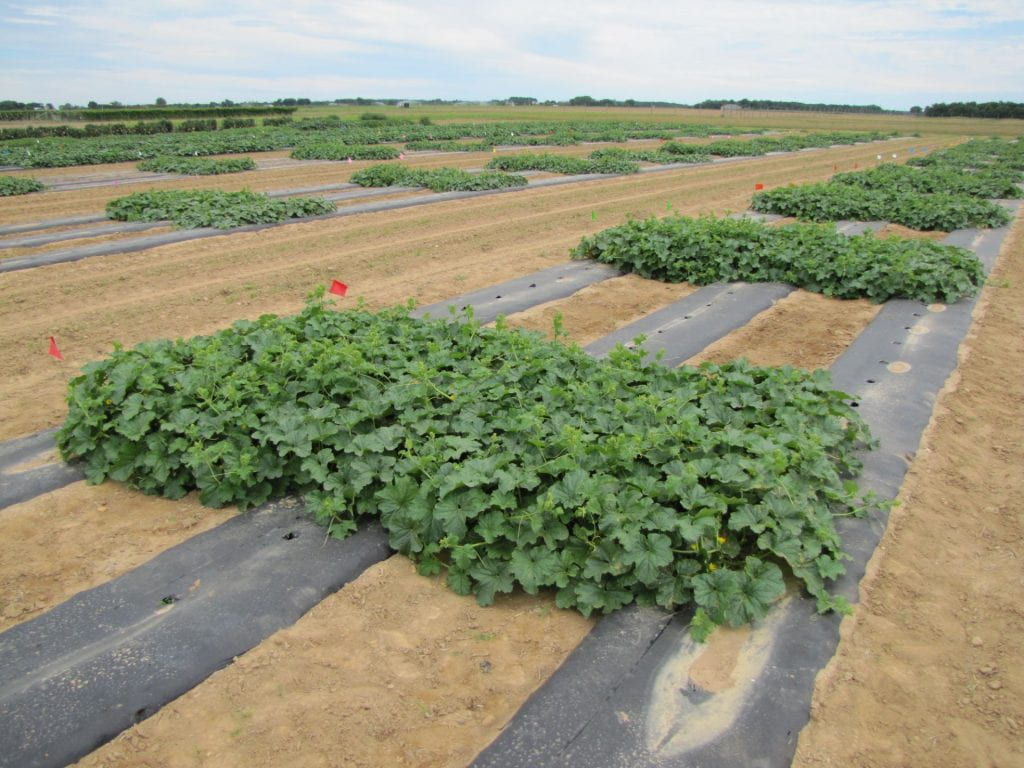
Figure 1. Photographs of plots of each variety taken on 12 September.
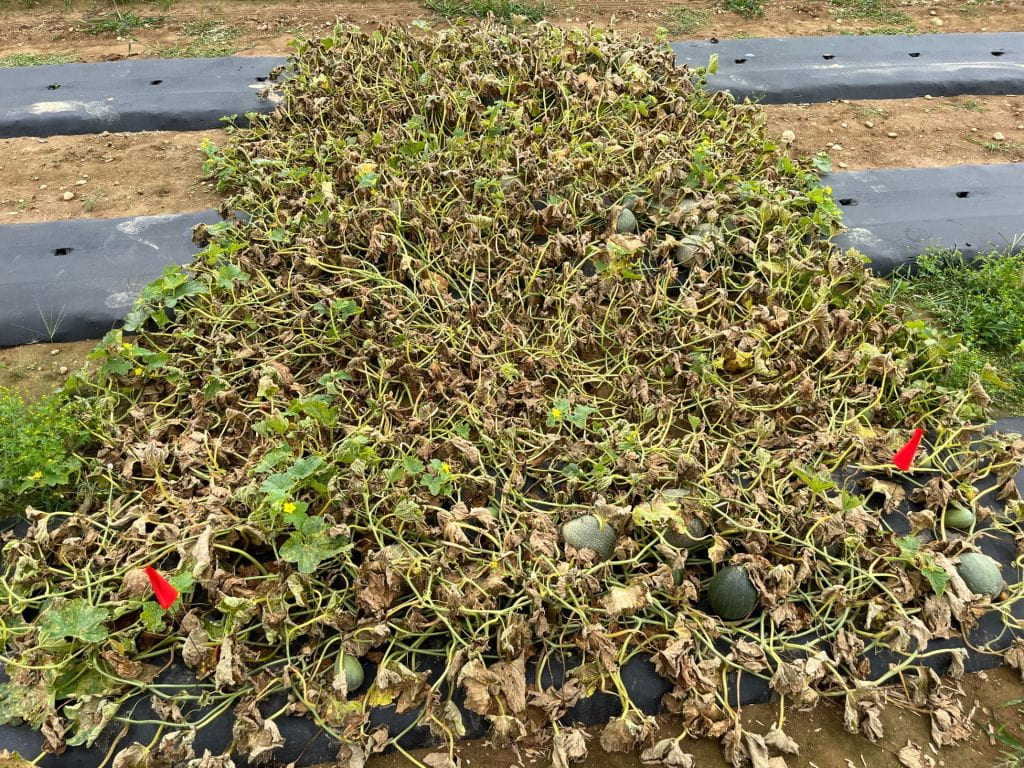
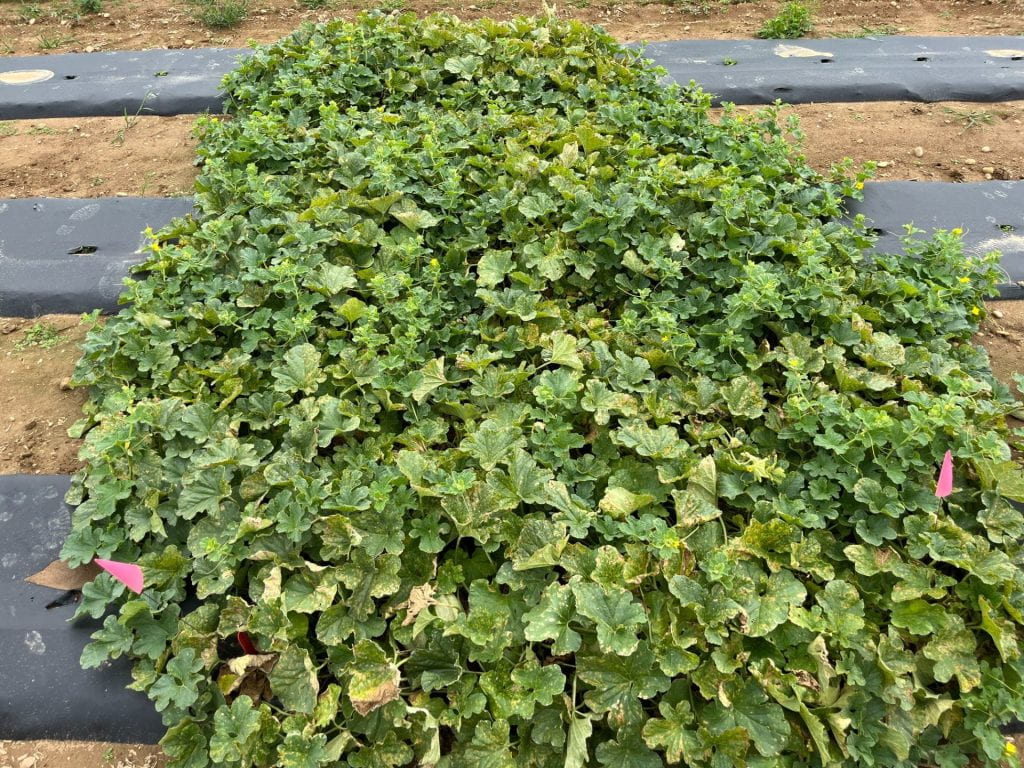

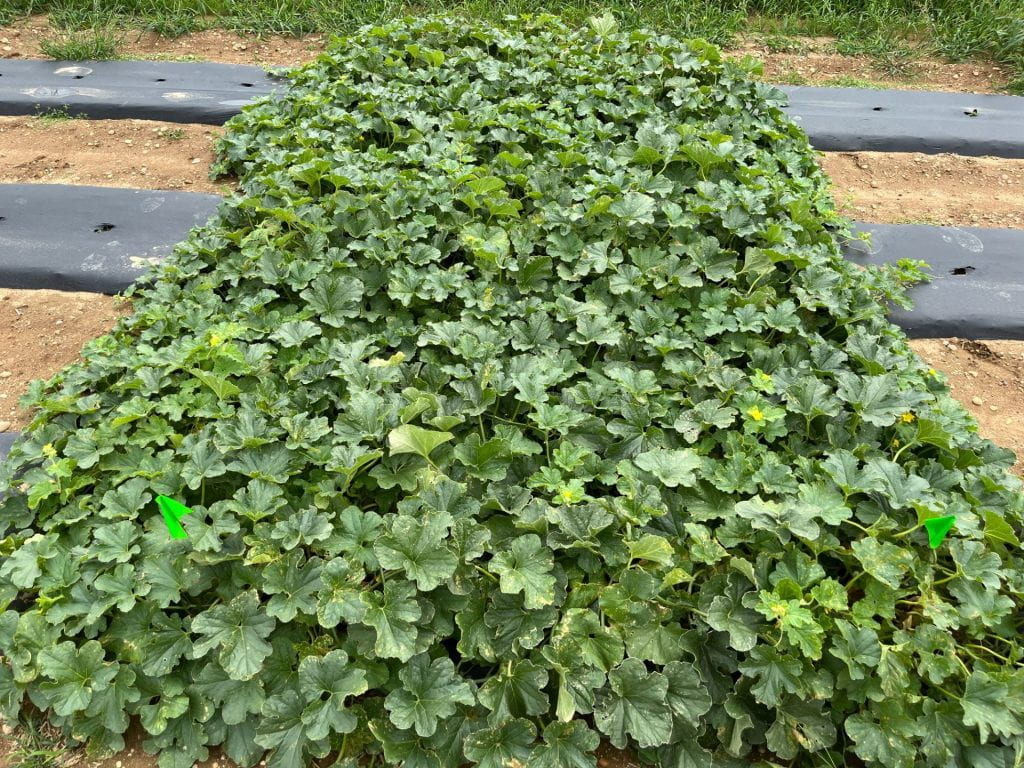
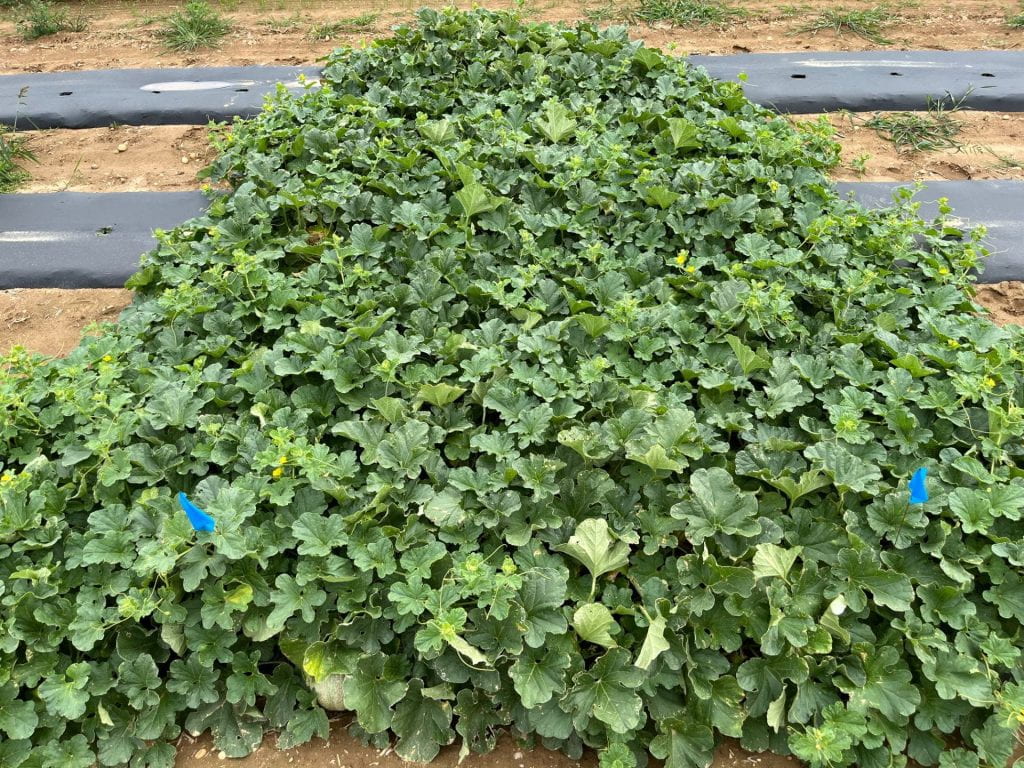
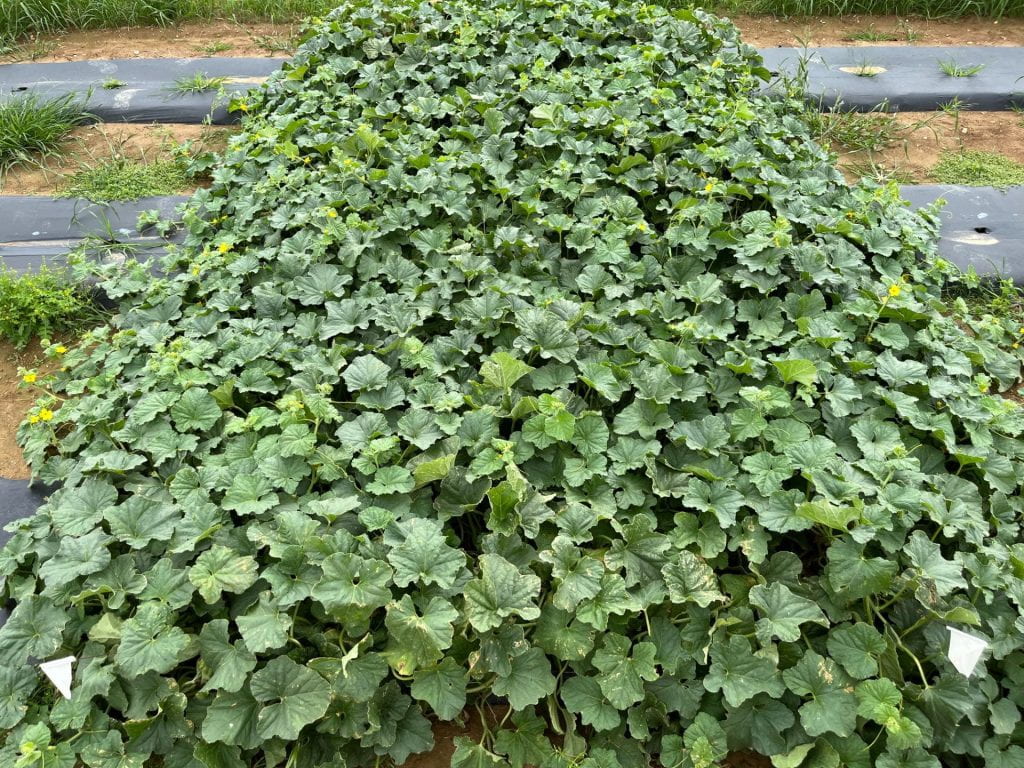

Figure 2. Fruit of cantaloupe varieties evaluated on 16 September.


